
* The Soviet Mikoyan aircraft design bureau built its first jet fighter, the "MiG-9", after the end of World War II. It was unspectacular, but it gave the organization experience to build a much better jet fighter, the "MiG-15", which leveraged off German swept-wing research and British engines. It led in turn to an improved fighter variant, the "MiG-15bis", and a tandem-seat trainer, the "MiG-15UTI". The MiG-15 would prove a shock to the Americans and their allies in the skies over Korea.
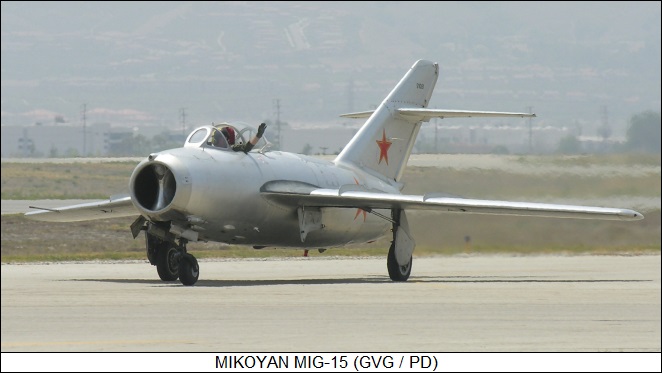
* During World War II, the Soviet Union lagged the West in development of jet combat aircraft, and as the end of the conflict approached, major efforts were made to catch up. There was considerable experimentation with "mixed power" aircraft, featuring both jet and piston engines, but for the most part these exercises went nowhere.
The experimental design bureau (OKB) run by Artyom I. Mikoyan and his deputy Mikhail I. Gurevich, designated "OKB-155" or just the "MiG OKB", developed the "Istrebitel (Fighter) 250" or "I-250" mixed-power fighter, which was built in small numbers. It was bizarre, a fighter with a hybrid engine, in which a piston engine drove a conventional propeller in the nose and a compressor in the rear fuselage, with the compressor feeding a combustion chamber to provide boost thrust. As long as the piston engine was there, it might as well be used to drive the jet engine, eliminating the need for an exhaust turbine to drive the compressor.
About 16 I-250s were built, with the type also known as the "MiG-13", but it was a dead-end concept and went no further. The MiG OKB also leveraged off German "rocket fighter" designs to build and fly two "I-270" rocket-powered fighter prototypes, but the I-270 proved another dead end. However, the Soviets had also obtained copies of Junkers Jumo 004 and BMW 003 jet engines from the defeated Germans, and these engines would provide a basis for the first generation of operational Soviet jet fighters. The Jumo 004 and BMW 003 were built by the Soviets as the "RD-10" and "RD-20" respectively, where "RD" stood for "reactivniy dvigatel (reaction engine)".
* In response to a state requirement issued in February 1945 for a pure jet fighter, the MiG OKB developed a twin-engine, straight-wing aircraft that was given the designation of "I-300". It was also referred to by the internal OKB code of "izdeliye F (model or product F)". The first of three prototypes performed its initial flight on 24 April 1946, with test pilot Alexei N. Grinchik at the controls, making it the first Soviet pure jet aircraft to take to the sky. It beat its competitor, the Yakovlev Yak-15 jet fighter, into the air by only an hour.
The I-300 was of all-metal construction and had a "tadpole" configuration, with twin engines mounted in the lower fuselage, exhausting under a tail boom. The low-mounted jet / tailboom configuration had been originally dreamt up by the Germans during the war, and the Soviets adopted it for a number of their early jet fighter designs. The underside of the tailboom was protected from the hot jet exhaust by a steel laminate heatshield, the design of which proved tricky.
The I-300 featured mid-mounted straight wings with slotted flaps and delta-style tail surfaces; a bubble canopy with all-round vision and an armor-glass windscreen; and tricycle landing gear, making it one of the first Soviet aircraft with such a landing gear configuration. All gear assemblies had single wheels, with the nose gear retracting backward and the main gear retracting outward into the wings. The cockpit was unpressurized and featured armor plating. There was no ejection seat.
The I-300 was fitted with twin RD-20 turbojets with 7.85 kN (800 kgp / 1,760 lbf) thrust each; some captured German BMW 003s were used as well. The engine intake was in the nose of the aircraft, with a bulkhead in the intake dividing the airflow to each engine. There were four bag-type fuel tanks in the fuselage and three in each wing, providing a total internal fuel capacity of 1,625 liters (429 US gallons). Wingtip external tanks with a capacity of 250 liters (66 US gallons) each were also developed.
Armament was initially planned to consist of a Nudelman N-57 57-millimeter cannon, mounted in the centerline engine intake bulkhead, and twin Nudelman-Suranov NS-23 23-millimeter cannon, firing out the lower lip of the intake. All three cannon had long barrels that stuck well out in front of the aircraft. The actual armament configuration of the three prototypes is a bit unclear; it appears they were initially flown with armament partially or completely replaced by ballast.
Although the I-300's excellent performance, much better than that of the best Soviet piston fighters, was obvious from the outset, it was also something new and unfamiliar; to no surprise, there were many teething problems with it, some of them deadly. Grinchik was killed in a crash on 11 July 1946 during a demonstration of all three prototypes to senior government aviation officials and VVS (Voyenno Vozdushniye Sily / Red Air Force) brass.
The positioning of the cannon was particularly naive, since it led to engine stalls caused by gun gas ingestion. The worst bugs were worked out while the MiG OKB built a batch of ten aircraft under a crash program, with the machines intended for a flyover of Red Square in November 1946 for the annual celebration of the Communist Revolution. The type had received the service designation of "MiG-9" by this time. The celebration was always used as a propaganda tool to show off the latest Soviet military hardware, and Soviet dictator Josef Stalin wanted to show that the USSR had fighters equal to those in the West. The fact that they weren't in full production at the time was not emphasized.
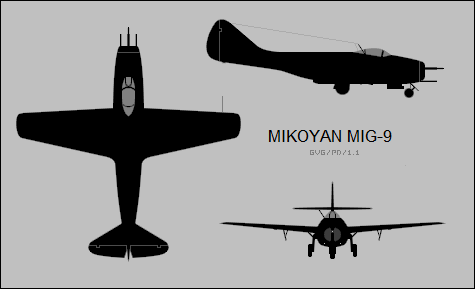
These ten aircraft amounted to preproduction machines; they featured a Nudelman N-37 37-millimeter cannon replacing the N-57 cannon. They were not really full production specification machines, since they still had a number of defects that had to be fixed before full production could start. The type went into VVS service in 1947, and a total of 610 was built in all, including prototypes and evaluation machines. NATO eventually assigned the type the reporting name of "Fargo".
MIKOYAN MIG-9: _____________________ _________________ _______________________ spec metric english _____________________ _________________ _______________________ wingspan 10.36 meters 34 feet wing area 18.2 sq_meters 196 sq_feet length 9.98 meters 32 feet 9 inches height 2.98 meters 9 feet 8 inches empty weight 3,570 kilograms 7,870 pounds MTO weight 5,070 kilograms 11,180 pounds max speed at altitude 900 KPH 560 MPH / 485 KT service ceiling 13,000 meters 42,650 feet range 1,100 kilometers 685 MI / 595 NMI _____________________ _________________ _______________________
A two-seat trainer, the "MiG-9UTI", was designed, with two prototypes built, the first being a modification of one of the MiG-9 prototypes. Initial flight was in early 1947. The MiG-9UTI featured a tandem-seat cockpit with dual canopies, the front canopy hinging to the right and the rear canopy sliding back. It was to be fitted with full armament and ejection seats, with the ejection seat design derived from that used on the German Heinkel He 162 jet fighter, and powered by an explosive cartridge. The rear seat cut the fuel load by a third. Trials showed the instructor's view from the rear seat to be unacceptable, but the need for a two-seat jet trainer was so great that the MiG-9UTI was approved for production in early 1948 anyway -- only to be canceled a few months later, since much more advanced aircraft were becoming available.
The MiG OKB tinkered a bit with the single-seat MiG-9 design, particularly with respect to the unsatisfactory armament configuration. Various quick fixes were tried, including the fit of a rectangular fin to the 37-millimeter cannon barrel, but none of them worked very well. Finally, the nose was redesigned so the cannon barrel muzzles were behind the engine intake, with the cockpit moved well forward on the redesigned nose. The result was the single "MiG-9M", which also featured an ejection seat and RD-21 engines, the RD-21 being an afterburning variant of the RD-20 / BMW-003.
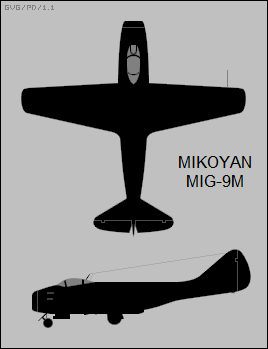
Although the MiG-9M entered trials in July 1947, by that time it was clearly old news, and the trials were abandoned in September. Work was also performed on building a derivative designated the "I-320" with the Rolls Royce Nene turbojet -- more on this powerplant below -- but that project was abandoned before the prototype was completed.
One very interesting subvariant of the MiG-9 that was actually flown was the "MiG-9L", a 1949 conversion of a single standard production MiG-9 to test the avionics for the "KS-1 Kometa" air-launched antishipping cruise missile (NATO reporting name "AS-1 Kennel"). Armament was removed; a radome was fitted in the nose for a radar transmitter; a small pod with a radar receiver was fitted to the leading inboard edge of each wing; a pod was fitted to the top of the tailfin for the missile radio control system; and a second cockpit with a small bubble-type canopy was fitted in the middle of the aircraft's back for a flight engineer.
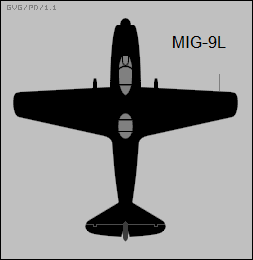
* The MiG-9 was roughly comparable to its contemporaries, such as the US Lockheed P-80 Shooting Star. However, aircraft design was moving rapidly at the time and the MiG-9's firstline service life was relatively brief; the MiG-9 and other contemporary Soviet fighters were basically developed and put into production as fast as possible to help the USSR keep up with the West and gain some experience with jet aircraft, while designers worked on better designs. The MiG-9 saw no combat action, and the only export user was China, with a number of MiG-9s provided in 1950 as single-seat advanced trainers.
BACK_TO_TOP* The quick progress of Soviet jet aircraft technology in the postwar years was greatly helped by foreign assistance. The Soviet production of German Jumo 004 and BMW 003 engines has been mentioned; the Soviets had also captured much information about German research into advanced aircraft designs, particularly swept-wing aircraft.
Not all the assistance was obtained as loot. Although Soviet engineers had been working on jet engines for some time, the German engines were in advance of anything the USSR had on hand at the end of the war, but the German engines still left something to be desired. They were of "axial flow" design, with a compressor made of axial fan blades on a shaft. Axial-flow engines would prove the way of the future for high-performance combat aircraft, but they were also tricky to get right and the Germans didn't have access to the materials needed to make them reliable. The British, however, had focused on the simpler "centrifugal flow" engine, in which the compressor used an "impeller" like that of a water pump. The centrifugal flow engine would eventually be displaced by the axial flow engine for high-performance aircraft, but it was easier to build than an axial flow engine and British engines were much more mature than German engines.
In 1946, Soviet aviation minister Mikhail Khrunichev and aircraft designer Alexander Yakovlev suggested to Stalin that the USSR buy advanced jet engines from the British. According to the tale, Stalin gave them an acid reply: "What fool will sell us his secrets?" However, he let the exercise go ahead, with Artyom Mikoyan, engine designer Valdimir Klimov, and others paying a visit to the UK. To Stalin's amazement, the British were perfectly willing to sell.
Not too surprisingly, this particular technology transfer remains the source of sarcasm and criticism in modern documents, including some written by Russians. The facts of the case are a bit more ambiguous. At the end of World War II, British Prime Minister Winston Churchill had been replaced in office by Clement Atlee, and Atlee was nowhere near as suspicious of the Soviets as had been Churchill, a Bolshevik-hater of long standing. The USSR had been Britain's ally in the war against Hitler when the Americans were still dawdling in the wings -- and though the Soviets had been troublesome allies, there was still some lingering sympathy with them. For the moment, relations between the US and Britain were poor, though they would quickly be repaired, and the technology in question wasn't classified anyway. However, some sources claim there were loud protests from the British Royal Air Force (RAF) and the Defense Ministry over the sale.
In any case, the Soviet delegation sent to Britain to arrange the deal came back with a license, technical data, and samples of the Rolls Royce Nene I, Nene II, and smaller Derwent 5 centrifugal flow turbojets, which were put into production as the "RD-45", "RD-45F", and "RD-500" respectively. Early production engine units were not very reliable; although the Soviets had detailed plans for the engines, fabricating the parts to the required level of quality took a little work.
* While the Soviets were working the bugs out of their copies of the Nene, in the spring of 1947 the MiG OKB was tasked to build a fighter that would be powered by it, basing the design on swept-wing research performed by the "Central Aerodynamics & Hydrodynamics Research Institute" ("TsAGI" in its Russian acronym) on aircraft. The project was given the designation of "I-310". The first prototype, powered by a British-built Nene engine, performed its initial flight on 30 December 1947, with Viktor N. Yuganov at the controls. As the date suggests, there was a deadline on getting the aircraft into the air.
The term "deadline" could have an only too literal interpretation in Stalin's USSR; however, the deadline was achieved not out of fear but because of a certain amount of capitalistic greed. The weather was poor at the time and there was no real problem in delaying the flight, but Yuganov was to get a bonus of 10,000 rubles if he flew the prototype, and he needed the money. He did two circles of the airfield under the cloud cover and landed. Artyom Mikoyan wasn't there to watch, but he phoned the pilot to congratulate him on the successful flight. The type would be assigned the service designation of "MiG-15" a few months later.
BACK_TO_TOP* The MiG-15 was clearly a generation ahead of the MiG-9, a leading-edge design by anyone's standards. It was a clean all-metal aircraft, built mostly of aircraft aluminum alloy, and featuring:
Armament included a single 37-millimeter cannon firing from the right lower lip and two 23-millimeter cannon firing from the left lower lip of the engine intake. The prototypes had featured exactly the same weapons as the MiG-9, including an N-37 37-millimeter cannon and two NS-23 23-millimeter cannon, but the production aircraft featured Nudelman-Richter NR-23 cannon replacing the NS-23 cannon, which raised the rate of fire from 550 rounds per minute to 850 rounds per minute. The NR-23 installation introduced little blisters on the fuselage behind the shell ejector ports, with the blisters designed to keep the spent shells from dinging the rear fuselage.
Ammunition capacity was 40 rounds for the 37-millimeter cannon and 80 rounds per gun for the 23-millimeter cannons. The cannon installation was slick, with the three cannon installed on a tray that was hand-cranked down out of the aircraft on cables for rearming or servicing. If additional trays were available, swapping in a preloaded tray would help provide rapid combat turnaround. A gun camera was mounted in the upper lip of the intake.
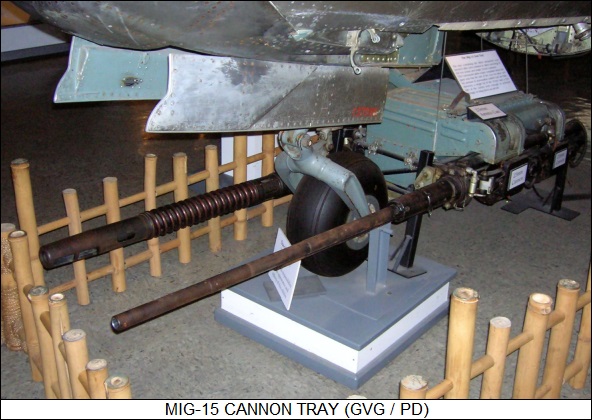
The MiG-15 could be fitted with a "slipper"-type external tank under each wing. There were three types of tanks available, with capacities of 250, 300, or 600 liters (66, 79, or 158 US gallons). The slipper tanks were "handed", meaning that the tank for the right wing couldn't be fitted to the left wing. The MiG-15 could also, in principle, carry a 100-kilogram (220-pound) bomb under each wing.
* There were still plenty of bugs to work out, not too surprising for such an advanced design. A second prototype made its first flight on 27 May 1948, followed by a third on 17 July 1948. The three aircraft were put through trials, leading to authorization for production that summer. A competing and roughly comparable fighter jet, the Lavochkin "La-15", was evaluated in parallel, to be authorized for production as well; but it was harder to manufacture, and it was built in much smaller numbers than the MiG-15.
Of course, a large number of changes were made to the MiG-15 as trials progressed. Hydraulically-actuated air brakes were added to the rear fuselage on the third prototype, since the aircraft tended to become difficult to control in a high-speed dive. The major reason, it appears, was because it was difficult to manufacture the aircraft to be perfectly symmetrical, and so it had a tendency to roll to one side that became more noticeable at higher speeds. Since one aircraft might tend to roll left while another might tend to roll right, trim tabs, called "nozhi (knives)", were fitted that could be adjusted by the ground crews. Eventually production quality would improve to the point where the asymmetry ceased to be an issue, though the knives were retained anyway.
Although VVS pilots evaluating the type for service use said it had a nasty tendency to bounce on landing, trials indicated that the real problem was pilot technique, due to unfamiliarity with an aircraft of unprecedented performance. Training procedures were developed to deal with the issue.
* The first production MiG-15 performed its initial flight on 31 December 1948. The production machines featured a wide range of small changes from the prototypes, including modifications to flight control surfaces; a redesign of the cockpit control arrangement; a new gunsight; and in particular a new engine fuel supply system that helped reduce the occurrence of flameouts at high altitude.
The MiG-15 entered VVS service in early 1949, with the USSR announcing its existence to the West with 45 MiG-15s overflying Moscow during the May Day parade of that year. It was assigned the NATO reporting name of "Fagot", meaning a "bundle of wood for burning" -- not "Faggot", an insulting comment on its sexual orientation and a common misspelling of the reporting name. However, sources still seem more reluctant to use the NATO reporting name for the MiG-15 than they are with other Soviet aircraft.
By 1950, the VVS would be using the fighter in their first jet flight demonstration team, the "Red Five", featuring MiG-15s painted red on top and a smoke generator under each wing. By the end of that year, the MiG-15 would be in combat.
BACK_TO_TOP* The Klimov engine OKB continued to refine the RD-45 engine, leading to an improved derivative, the "VK-1" -- "VK" standing of course for "Vladimir Klimov" -- providing 26.5 kN (2,700 kgp / 5,950 lbf) thrust. The new engine led to introduction of an improved MiG-15 variant, the "MiG-15bis", with initial flight on 2 July 1949; the "bis" was Latin or French for "encore" or "again", and the designation might be translated as "MiG-15 Plus". The MiG-15bis demonstrated incremental improvement in performance all around. Along with the uprated engine, which had a slightly different form factor from the RD-45F and required some fuselage modifications, the MiG-15bis also featured a wide range of minor improvements in aerodynamics and aircraft systems, most significantly hydraulically-boosted ailerons to improve roll performance.
The slipper-type external tank provided for the MiG-15 was replaced by a teardrop 400-liter (106 US gallon) tank that was carried on a pylon using bracing struts. The teardrop tanks were not "handed": they could be carried under either wing. Later production teardrop tanks were fitted with twin tailfins to improve drop separation. It appears that the MiG-15bis could still carry the older slipper tanks.
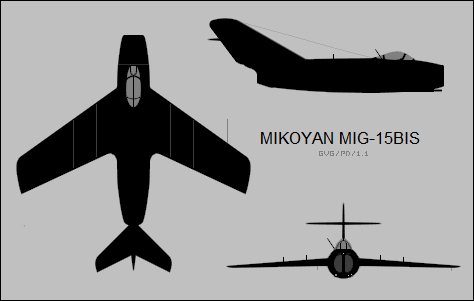
The MiG-15bis entered VVS service in late 1950. NATO assigned it the reporting name of "Fagot-B", retroactively making the original MiG-15 the "Fagot-A". The MiG-15bis would become the main production variant.
A number of further improvements were added to the MiG-15bis during production, including replacement of the NS-23 23-millimeter cannons with NP-23 23-millimeter cannons, providing a 50% higher rate of fire; a modified canopy providing a better field of view; cockpit pressurization bleed for a gee-suit; bigger dive brakes; more cockpit armor; a Sirena-2 radar warning receiver (RWR); and an electrical engine self-starting system, eliminating the need for a ground cart. A few MiG-15bis "Fagot-Bs" were built with a brake parachute and antiskid braking system, though they were not standard kit.
MIKOYAN MIG-15BIS: _____________________ _________________ _______________________ spec metric english _____________________ _________________ _______________________ wingspan 10.06 meters 33 feet 1 inch wing area 23.7 sq_meters 255 sq_feet length 11.05 meters 36 feet 3 inches height 3.4 meters 11 feet 2 inches empty weight 3,680 kilograms 8,115 pounds MTO weight 6,125 kilograms 13,500 pounds max speed at altitude 1,075 KPH 670 MPH / 580 KT service ceiling 15,515 meters 50,900 feet combat range 1,625 kilometers 1,010 MI / 875 NMI _____________________ _________________ _______________________
Most MiG-15 family aircraft originally flew in natural metal colors, though there were some special bright paint jobs for airshow demonstration machines. In the late 1950s, many MiG-15bis fighters were shoehorned into the fighter-bomber role, being fitted with an additional stores pylon under each wing for carriage of a bomb or unguided rocket launcher. These machines were often painted in disruptive camouflage color schemes. Of course there were special color schemes, such as the overall red color for the "Red Five", and one American pilot even reported shooting down a MiG-15 during the Korean War that had a dragon painted along the full length of the fuselage!
The only thing that could be said in favor of the MiG-15bis fighter-bomber conversions was that they were better than nothing. They lacked the armor needed for the "mudfighter" mission; their warload was minimal; and they had no targeting gear, except the standard gunsight. Unguided rocket pods were a preferred store, since they could be effectively aimed using the gunsight, with the cannon fire used to "register" a target before loosing a salvo of rockets on it. Cluster munitions were also useful, since they didn't need precise aiming. The MiG-15 was strictly a stopgap type in the close-support role.
* An "escort fighter" variant of the MiG-15bis, the "MiG-15bisS", was produced, the main change being carriage of a 600-liter (158 US gallon) external slipper tank under each wing. The big tank required wing modification. The MiG-15bisS also included a larger pilot oxygen supply and other tweaks. The big external tanks almost doubled the fighter's endurance. A total of 49 was built beginning in 1951.
A reconnaissance version, the "MiG-15bisR", was produced as well. It was fitted with a single vertically-mounted camera replacing one of the 23-millimeter cannon. It usually flew with the 600-liter long-range tanks. A total of 364 was built. Apparently there were a few other reconnaissance configurations, performed as experiments or conversions.
BACK_TO_TOP* Since the MiG-15 presented the VVS with an aircraft of entirely new levels of performance, there was an obvious need for a two-seat trainer based on it, and such an aircraft was specified in a state requirement issued in April 1949. A new-build prototype of a tandem-seat version of the standard early-production MiG-15 "Fagot-A" was built, performing its initial flight before summer. Trials proved the aircraft acceptable, and it entered production in the fall of 1950 as the "UTI MiG-15" AKA "MiG-15UTI". It was assigned the NATO reporting name of "Midget".
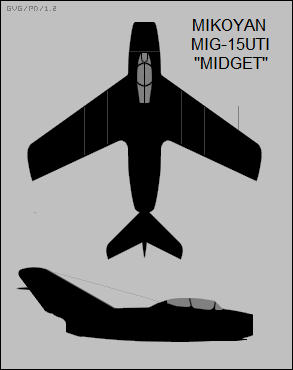
The tandem cockpit featured dual canopies, the one in front hinging open to the right and the one in the rear sliding backward. The rear cockpit was accommodated by reducing internal fuel storage. Some sources claim the machine was also substantially stretched, but this can be seen to be wrong by simply looking over photographs or artwork; the MiG-15UTI was the same length as the MiG-15. The MiG-15UTI was powered by the RD-45F engine and had reduced armament, originally consisting of one NR-23 23-millimeter cannon and a 12.7-millimeter machine gun; the 23-millimeter cannon was soon deleted from production.
The MiG-15UTI was produced in substantial quantities, becoming the standard advanced trainer for the USSR, Soviet satellites, and client states, and remained in first-line service well into the 1970s, long after the MiG-15 fighter itself was obsolete. The MiG-15UTI received a series of small upgrades through its life to keep it relevant to the aircraft that cadets would eventually graduate to fly. Although the "Midget" had a few handling quirks, it was apparently fun to fly, not to mention very sturdy and reliable; it was called the "Babushka (Granny)" and "Matushka (Nice Old Lady)". It was sometimes called a "Sparka" as well, but that name just meant "twin", and applied to two-seat trainers in general.
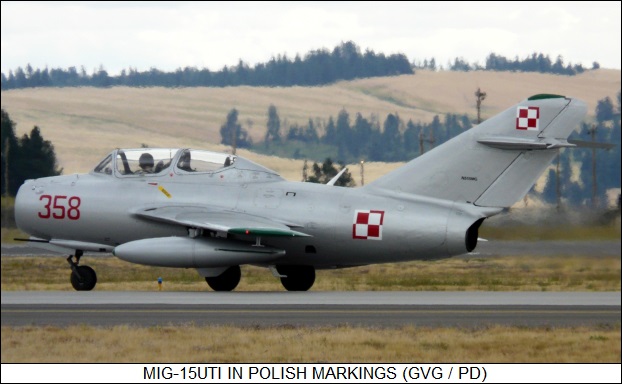
The MiG-15UTI was also supplied to DOSAAF, a paramilitary organization that gave students outside the military flight training for a possible future career in the armed services. Another user was the Soviet cosmonaut corps, which used the type to maintain flight proficiency and, presumably, as "hacks" for getting around a big country. Cosmonaut Yuri Gagarin, the first man to fly in space, was killed in a MiG-15UTI along with a comrade officer on 27 March 1967. Visibility was poor that day, and due to miscommunications they flew the trainer into the ground.
BACK_TO_TOP* There were quite a few trials modifications of the MiG-15. Some were fairly minor, such as testbeds for improved engines, armament, or flight surfaces. Other modifications were more substantial.
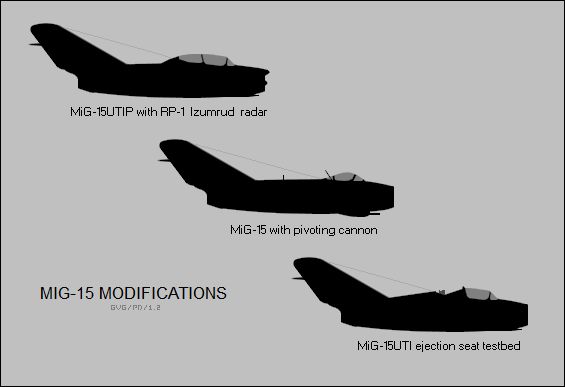
Considerable work was performed on fitting the MiG-15 with radar for service as an all-weather interceptor. In 1950, a MiG-15bis fighter was modified to an all-weather interceptor configuration with "Toriy (Thorium)" radar in a large nose radome. The result had an appearance faintly reminiscent of the US North American F-86D Sabre; the aircraft was armed solely with a single 37-millimeter cannon, shifted closer to the centerline. The gun camera was relocated to the right side of the inlet.
Five new-build machines with the Toriy radar were built in 1951, with some sources identifying them with the designation of "MiG-15bisP". Incidentally, five Lisunov Li-2 twin-piston transports, license-built copies of the Douglas C-47 Dakota, were fitted out as radar trainers. The exercise was abandoned because the Toriy radar was too complicated for the pilot to deal with while he was trying to fly the aircraft. The radar was also a completely unreliable piece of junk, the USSR having problems in manufacturing the required electronic components for the moment.
Somewhat more successfully, in 1950 a MiG-15bis fighter was modified to carry the "RP-1 Izumrud (Emerald)" radar. The Izumrud was less ambitious than the Toriy, being essentially a radar gunsight, and in fact the "RP" code meant "radiopristel (radio sight)". The Izumrud actually consisted of two radars, a search radar fitted in the upper intake lip, giving an appearance vaguely like the F-86E Sabre, and a tracking radar in a radome mounted on the intake splitter. Armament was reduced to the two 23-millimeter cannon, with a cannon on each side of the intake, and the gun camera was relocated to the right side of the inlet.
The modification featured a peculiar gun camera mounting on top of the canopy in what looked like a slightly oversized rear-view mirror housing, with the camera taking pictures through the gunsight using a mirror arrangement. The Izumrud radar was also fitted to three MiG-15UTI trainers, which were given the designation of "MiG-15UTIP". The Izumrud would not be fitted to any production MiG-15 fighters, but it would become a popular fit for the next generation of MiG fighters.
Interestingly, in 1952 a MiG-15bis was fitted with a complete copy of the US AN/APG-30 radar gunsight used by the F-86, with the copy designated the "SRD-3 Grad (Hail)". A sample of the AN/APG-30 was obtained from an F-86A that crash-landed behind Red lines in Korea in 1951. The Izumrud radar turned out to be the better bet. Incidentally, there was lobbying to actually produce a Soviet F-86, but it didn't really make sense, and the idea went nowhere. The USSR had succeeded in catching up with Western aircraft designs, and the most the Sabre could do for the Soviets was provide some interesting ideas.
Other modifications included:
Total Soviet production of the MiG-15 family was over 13,100 aircraft, including about 1,345 MiG-15 "Fagot-As", 8,2326 MiG-15bis "Fagot-Bs" (including subvariants), and 3,430 MiG-15UTI "Midgets".
BACK_TO_TOP* The MiG-15 was extensively produced outside the USSR. Beginning in 1953, following the assembly of Soviet-supplied knockdown kits, the Aero organization factory at Vodochody (pronounced "vodo-kody") in Czechoslovakia produced the MiG-15 as the "S-102", with 821 built; followed by the MiG-15UTI as the "CS-102", with 2,013 built; and the MiG-15bis as the "S-103", with 620 built. Some of the CS-102 "Midgets" featured a 23-millimeter cannon instead of a 12.7-millimeter machine gun. In the late 1950s the Czech designations were dropped and these machines reverted to their original Soviet designations. The RD-45F and VK-1 engines were also built in Czechoslovakia, by the Motorlet organization.
Czech-built MiG-15s were used in the USSR and exported around the world. They were regarded as the best-built MiG-15s, the Czechs having a long tradition of precision manufacturing. A number of modifications were performed on the Czech machines:
The Czechs also came up with a particularly outrageous MiG-15 modification: they took the front fuselage and engine of a MiG-15 and mounted it on the back of a 6x6 truck for use as a runway deicer. One hopes the throttle was bolted with a hard limiter to keep the "pilot" from trying to see how fast he could get the truck rolling.
* Although the Czechs were the most enthusiastic foreign manufacturer of the MiG-15 series, the Poles were actually the first to build the type outside of the USSR. Following assembly of a number of Soviet-supplied knockdown kits, the WSK factory at Mielec began production of the MiG-15 in 1952 as the "LIM-1", with about 227 built in all, and WSK rolling production to the MiG-15bis in late 1953 as the "LIM-2", with 500 built. The RD-45F and VK-1 engines were also license-built by WSK Rzezow in Poland as the "LIS-1" and "LIS-2" respectively.
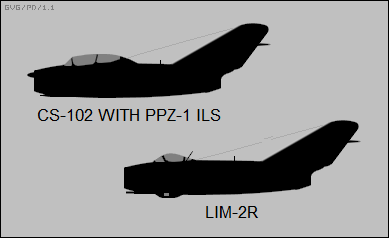
Some LIM-2s built in a reconnaissance configuration and designated "LIM-2R". Some LIM-1s were upgraded with the improved avionics of the later-production MiG-15bis and were known unofficially by the designation of "LIM-1.5". A few LIM-1s and LIM-2s were operated as target tugs by the simple measure of fitting them with a hook for a target sleeve behind the nose gear door.
Some sources claim that a small of LIM-2s and maybe some LIM-1s were exported to East Germany, but otherwise they were only operated by Polish forces. The Poles did not build the MiG-15UTI, though apparently a number of LIM-1s and LIM-2s were factory-converted to the UTI configuration, to be designated "SBLIM-1" and "SBLIM-2" accordingly. There was some variation in armament fit of Polish "Midget" conversions, at least some having twin 23-millimeter cannon. A number were configured as battlefield reconnaissance / artillery spotting machines, with camera controls replacing the flight controls in the back seat, and designated "SBLIM-1Art" and "SBLIM-2Art". Two SBLIM-1s were also configured as ejection seat testbeds.
Not to be outdone by the Czechs in outrageousness, the Polish state railway actually "flew" a number of MiG-15s on trains, simply mounting the fuselage on a flatcar and using the downward-angled jet exhaust to clean off the railroad tracks.
* Although the Soviets worked with the Chinese on license-producing the MiG-15bis, by the time the Chinese were ready to do so, the MiG-15bis had been replaced by the next-generation MiG-17, discussed in the next chapter. China never built the MiG-15 or MiG-15bis, though large numbers of Soviet-supplied MiG-15bis machines were supplied to the Chinese People's Liberation Army Air Force (PLAAF). They were given the designation of "J-2", the "J" standing for the Chinese word for "fighter", and some were passed on to Chinese client states.
The Red Chinese did, however, build the MiG-15UTI, designating it the "JJ-2". It served with the PLAAF into the 1970s. The JJ-2 was also exported to Chinese client states under the designation of "FT-2".
BACK_TO_TOP* At the outset of the Korean War on 25 June 1950, the North Korean Air Force was equipped with piston-powered aircraft provided by the USSR, such as the Yakovlev Yak-9 and Lavochkin La-11. Once the US Air Force got organized, they swept the North Koreans out of the sky. However, in November 1950, the US was alarmed to be confronted by a new, advanced jet fighter that was heavily armed and left US Air Force (USAF) Lockheed F-80 Shooting Star and Republic F-84 Thunderjet fighters in the dust. The MiG-15 had arrived, with Soviet pilots flying the aircraft. The USAF quickly shipped new F-86 Sabres to the battle theater to confront the MiG-15s, and the struggle for air supremacy was on.
It is hard to imagine any two more evenly matched opponents than the MiG-15 and the F-86 Sabre. They even had a general configurational resemblance to each other, which made "friendly fire" incidents a dangerous nuisance all through the conflict. Some Westerners suspected that the MiG-15 was actually a Sabre, built from blueprints stolen by Red spies, but that was nonsense: both designs had their roots in German engineering, they had been developed very much in parallel, and they were completely different at the detail level. The MiG-15 was actually significantly smaller than the F-86, with only about 80% of the empty weight, though it tended to look bigger because its fuselage was relatively plump, as dictated by its VK-1 centrifugal flow engine. The slender Sabre arguably had the edge in sheer good looks, but the MiG-15 had an admirable warlike style of its own.
The capabilities of the two designs tended to reflect the goals for which they had been designed. The primary design goal of the MiG-15 was as a bomber interceptor: it had a faster rate of climb and better high-altitude performance, though the late-model F-86F would have a performance edge on the MiG-15bis. The primary design goal of the F-86 was as an air-superiority fighter; it had a slight edge in general maneuverability, and better low-altitude performance. The armament of the two aircraft also reflected these goals. The heavy cannon of the MiG-15 helped ensure kills on big bombers, while the high rate of fire of the Sabre's six 12.7-millimeter Browning machine guns helped ensure a higher probability of hits in a dogfight.
The relative merits of the armament of the two types remains a matter of debate: it seems that the MiG-15's powerful but slow-firing armament was an advantage for pilots who were good shots, while the Sabre's lighter but faster-firing armament was an advantage for those who weren't. The Americans would concede that the 12.7-millimeter Brownings really did lack punch -- some Soviet pilots contemptuously called them "pea-shooters". The US performed experiments with heavier armament for the F-86, and more or less standardized on 20-millimeter cannon for the next generation of fighters. Postwar Australian-built Sabres would actually have twin 30-millimeter Aden revolver-type cannon, which would have no doubt got plenty of respect from Soviet pilots had they ever had the opportunity to come up against them.
The Sabre had something of the edge in sophistication, particularly with its radar gunsight. Its high-seated cockpit arrangement also provided the pilot with a superb field of view, though on the other hand the low seating of the MiG-15 gave the pilot more protection. There were a number of nasty little features of the MiG-15 that pilots didn't care for, such as the fact that there was an ejection lever only on one side; if the pilot was injured he might have to reach across his seat with his other arm to eject, which was a dangerously awkward position to be in when he was going to be, in effect, shot out of a cannon. Some sources claim an ejection seat with levers on both sides was introduced into MiG-15bis production in 1952; in any case, the ejection seats on later MiG fighters would have twin levers.
The usual "get it working" philosophy of Soviet engineering also meant that niceties were secondary considerations, and Soviet pilots who examined the well-thought-out survival kit carried by F-86 pilots were envious, sending examples back to the USSR for consideration by the engineers. Soviet pilots fighting in Korea also had nothing to compare with the American search and rescue organization -- though since they rarely if ever operated over hostile territory, it was less of a necessity.
On the plus side, Soviet pilots regarded the MiG-15 as much sturdier than the F-86, and it seems evident that the MiG-15 featured the famous "tractor toughness" of the best Soviet gear. Pilots warmly called it the "samolyot-soldaht (soldier aircraft)". Many pilots insisted that MiG-15s that were claimed by the enemy as "kills" often made it back home and lived to fight on. Overall, as combat aircraft the MiG-15 and F-86 were so comparable that pilot skill was clearly the deciding factor in the air battle.
* In the end, the Americans would claim an 8:1 kill ration against the MiG-15. Russian sources insist that this claim is exaggerated, and in return Soviet pilots have claimed a comparable kill ratio against American types. Anyone experienced with the whole tiresome subject of kill ratios would feel fairly certain that both sides made exaggerated claims. However, there are good reasons to believe that the Americans did rack up an impressive kill ratio against the MiG-15, though not because of any real defect of the type.
The Soviets withdrew their pilots early in the war, and most of the Sabre's victims were piloted by Chinese and North Korean pilots who were very inexperienced. Flying a fighter is a little like playing a piano -- something few learn quickly, and something some can never really learn at all. There were reports that sometimes MiG-15 pilots would eject instead of facing combat, though these stories might have just been windy fighter pilots telling tall tales.
Russian pilots later admitted that most Chinese and North Korean pilots were doing little more than providing the Americans with "aerial targets", though of course some of the Chinese and North Koreans were "naturals" -- pilots who understood how to fly and fight almost by instinct. Some Russian pilots even admitted that the Americans often had the edge in skill because the Americans got more flight training hours, and because Soviet squadrons were rotated through the combat theater on a bureaucratically rigid and relatively short cycle, preventing pilots from acquiring extensive combat experience and passing it on to green pilots.
* Late in the war, the Americans dropped leaflets over enemy airfields offering $100,000 USD to any pilot who would defect with a MiG-15. The exercise was codenamed Operation MOOLAH, with "moolah" being an antique American slang term for "big money". One Russian source, understandably baffled, translated it as Operation MULLAH, which must have seemed almost as baffling. Although no doubt dire threats were made about reprisals, a Lieutenant Ro Kim Suk did decide to defect and flew his MiG-15bis south on 21 September 1953.
The aircraft was evaluated by famed USAF test pilot Chuck Yeager, who made a number of arguable statements about it in his memoirs, suggesting not only that it was extremely dangerous in a dive, but that Soviet pilots he had chatted with during a later trip to the USSR agreed with him. When the said pilots found out about this claim, they all replied: "BULL SHIT!". One Russian source suggested that the claim was an invention of Yeager's co-author -- apparently being unaware of Yeager's notorious windiness and inclination to exaggerate accomplishments that were impressive enough not to need it. Ro Kim Suk's MiG is now on display at the US Air Force Museum in Dayton, Ohio.
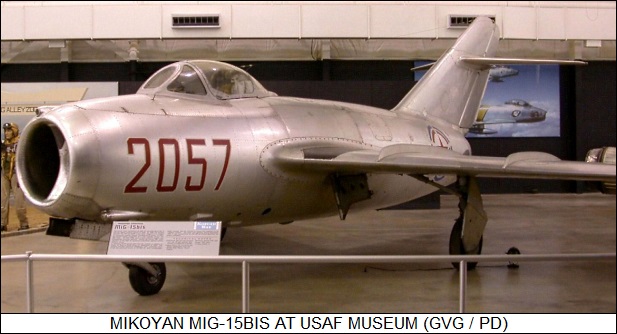
* Soviet MiG-15s would continue to see action for a few years after the war in encounters with Western spy planes that occasionally intruded into Soviet airspace. There were other incidents in which the Soviets attacked spy aircraft in international airspace, usually after overflights or other provocations; a few attacks on airliners that got lost; and isolated incidents where they shot up other Soviet aircraft by mistake.
They also had encounters with Western spy balloons set adrift over Eastern Europe and the USSR. The balloons usually floated much too high for aircraft to reach, but occasionally they fell down to altitudes where they could be fired on, as well as become a hazard to air navigation. The story of the balloons is obscure: the US sent over hundreds for a few months in early 1955, and sent three improved balloons over the USSR in 1958 -- but the exercise proved ineffectual, the Soviets complained very loudly, and the effort was given up. Russian sources still insist that reconnaissance balloons were sent over the USSR into the 1970s; whether they were part of some program that was never declassified and was forgotten, or if the Soviets were just getting upset over stray weather balloons, is unclear.
* The MiG-15 was the standard Soviet air combat fighter of the early 1950s, and it was accordingly supplied in large numbers to Warsaw Pact nations, as well as to almost every Soviet client state in Africa and Asia. The MiG-15UTI continuing to be exported long after the MiG-15 and MiG-15bis were obsolete. The Finns, who have traditionally acquired an interesting mix of Western and Eastern gear, obtained four MiG-15UTIs.
Red Chinese MiG-15s would have occasional encounters with Taiwanese F-86s and other Taiwanese aircraft during the early 1950s, with both sides claiming kills. Both Egypt and Syria were equipped with MiG-15 "Fagot-A" and MiG-15bis "Fagot-B" fighters from the mid-1950s, and these aircraft would see combat in the 1956 and 1967 Arab-Israeli Wars. They claimed some kills during the 1956 war, but they were largely destroyed on the ground in the opening blitz of the 1967 war. A few Egyptian MiG-15s did perform ground-attack sorties during the 1967 war, but these missions were suicidal, since by that time the MiG-15 was hopelessly obsolete for air combat, and no match for Israeli fighters.
* The last military operator of the MiG-15 was Albania, which operated a handful of MiG-15bis and MiG-15UTI machines up to late 2005. However, so many MiG-15s were built and the things are so rugged and reliable that a good number persist in private hands, flying as elite toys and as airshow demonstrators.
BACK_TO_TOP